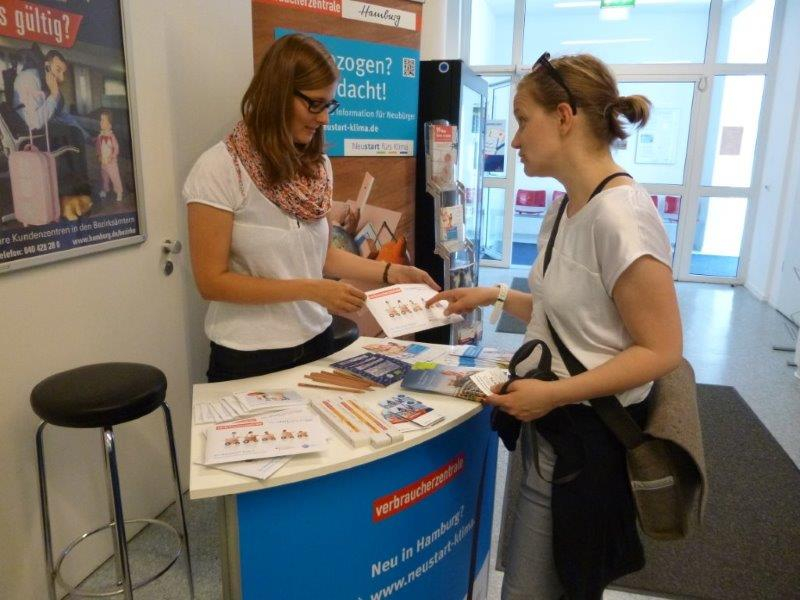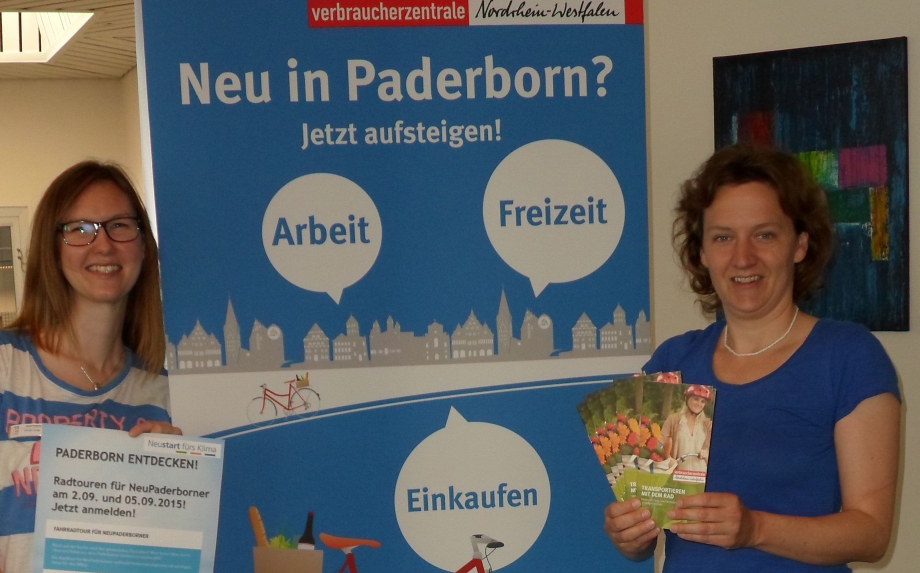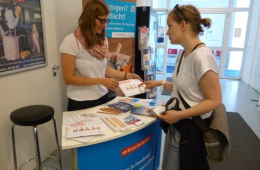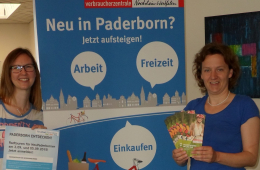A reboot for the climate
Climate action and consumer advice for newly arrived residents in six model communities
Projektnehmer
Consumer centres (‘Verbraucherzentralen‘) in Hamburg, Hesse, North Rhine-Westphalia, Rhineland-Palatinate, Saarland and Saxony-Anhalt; and Öko-Institut e.V.
Projektlaufzeit
01.07.2012 bis
30.06.2015
Fördersumme
2,422,585 € Euro
Förderkennzeichen
03KSF022-EN
Förderprogramm
Motivating newly arrived residents for climate action
Moving from one place to another gives us the opportunity to let go of or reconsider old habits and, more importantly, to set the course for a new, more climate-friendly behaviour.
At a glance
This is where the project ‘Neustart fürs Klima’ (A reboot for the climate) sets in. Consumer centres from six German federal states designed a welcome package specifically for newly arrived residents, showing them the various possibilities for an eco-friendly lifestyle in their new home. Information leaflets on climate-friendly mobility, food from the region and other sustainable lifestyle choices were handed out to newcomers at town halls (where people go to register their place of residence) and other municipal offices. In this way, the relocation took off to a climate-friendly start!
Right on from the very start!
In cooperation with the local authorities, the project experimented with various formats for providing information on eco-friendly living to new residents – from welcome letters to city tours and information evenings. Six consumer centres in the cities of Alzey and Wörrstadt, Bonn, Dillingen (Saar), Hamburg, Halle (Saale) and Kassel took part. Scientific support was provided by the Öko-Institut.
The main focus was on food, energy and mobility. There was information on local food buying, electricity saving and the best bike routes to take. The new residents’ package also included practical guides such as free city maps, lists of mobility options and tips on where and how to shop. The package was supplemented with coupons for the use of local public transport or for shopping at an organic food store. During the project, the existing project material was adopted and localised by a total of fifteen municipalities and used for newcomers there.
The project sequence: testing, optimising and disseminating
In the model communities Alzey/Wörrstadt, Bonn, Dillingen (Saar), Halle, Hamburg and Kassel, the methods for addressing the targeted parties were first tested and then aligned on the basis of the experiences using a uniform scheme. In order to promote the transfer of results, a manual was developed for municipalities aimed at seizing the opportunities for motivating new residents to adopt eco-friendly habits. Aside from illustrating the role that citizens and residents are playing in municipal climate action, the manual offers advice for assessing a municipality’s as-is state in terms of climate action and for developing a municipality’s own communication strategy.
In addition, the manual describes measures such as the new residents' package, which had proved successful in practice. In addition, checklists, brochures, flyers and fact sheets of individual measures were developed, which remained available on the project website after completion of the project. In this way, other municipalities can benefit from the experience and use the materials and procedures according to their needs. Finally, the project partners and municipalities also discussed the project results, experiences and best practices how to win new citizens for climate action at a nationwide meeting.
How to best reach them …
For minting new habits, new residents should be approached as early as possible after a move. The following three ways of addressing them proved helpful for designing the local concepts in the model communities.
… Inform and make curious
The project targeted specific places and events: town halls (where people go to register their place of residence), integration courses and the first day of the semester at universities. The municipalities sent welcome letters to the new residents, addressing them personally. The newcomers, in need of orientation and curious about their new place of residence, were receptive to this information.
… getting them all talking
Guided tours, bike tours and similar offers allowed the new inhabitants to actively get to know their new city and its infrastructure and to make contact with other new residents or the local population. With this community experience, the participants were able to mix business with pleasure. What better motivation for ingraining climate-friendly behaviour?
“The cress seed bags were an ideal give-away at this booth. The visitors of the booth readily took them with them and were able to start gardening once they got home. I myself tasted fresh farm bread with cress at the stand and thereby got to experience seasonal local food.”
Dr. Ruth Gütter, member of the state consistory, Protestant church of Kurhessen-Waldeck
… facilitating everyday action
The third way was to provide examples of everyday behaviour within the community. Indeed, many climate-friendly measures are easy to implement and have additional positive side effects. A change in the electricity provider or the switch to public transport or car sharing, for example, can have a financial or social added value. Other more focused or theme-specific events (e.g., cooking evenings) gave the opportunity to try out eco-friendly action alternatives and to implement them in everyday life.
-
What were the project goals?
- Advice for new residents on mobility, energy savings and climate-friendly foods;
- Transfer of experiences, through a manual and municipal networks, so that they can serve as an example and template for municipalities across Germany.
-
What did the project achieve?
- Direct implementation in six model municipalities with proven CO2 savings;
- Duplication in 15 other municipalities;
- Further interest expressed by 27 municipalities.
-
What happened next?
- Transfer of results and experiences to municipalities upon project completion; adaptation of materials to individual needs and implementation;
- Use of the service offer for municipalities presented on the project website;
- Implementation of selected project measures in around 40 municipalities throughout Germany beyond the project duration.
Contribution to climate action
The contribution of this project to climate action is difficult to quantify, since people’s personal carbon footprint changes as it is with every move from one home to another. However, based on the records of some 261 consultations over the duration of the project (2012 to 2015), the project achieved a reduction of 747 tonnes of CO2. This represents nearly three tonnes per consultation. In addition to the in-person consultations, the project also replied to some 2,000 written and telephone inquiries on specific topics. These brief consultations led to savings of about 300 tonnes of CO2.
An online survey that ran until the end of the year 2014 gave insight into the behaviours, and changes thereof, of 324 newcomers over a longer period of time. The evaluation of the survey showed that a CO2 emissions reduction of 433 tonnes had been achieved. Among the topics inquired about in the survey, the food sector proved to be the most important. By switching to a diet that focused on seasonal and local products, less meat as well as more organic products, a CO2 emissions reduction of 139 tonnes was achieved. The second most important area was mobility. Here, a reduction of 121 tonnes was achieved when people left their cars parked and switched to cycling or public transport.
-
Checklist for success
- Differentiated and personal approach;
- Taking consideration of the local situation;
- Provide concrete incentives and offers;
- Active way of addressing, using good materials and positive messages.
Lessons learned
The project can be relatively easily transferred to other municipalities. However, any such replication would do well to learn from the experiences made thus far.
Meeting newcomers halfway – with relevant information
Just like the existing population, new residents are not a homogeneous group. Rather, they belong to different milieus whose interests (in climate-related topics) are likewise very different. For this reason it is important to highlight any additional positive effects of climate-friendly behaviour, such as financial gains or an enhanced quality of life, resulting from, for example, the use of public transport or car-sharing offers.
The targeted placement of the offers and information in places likely to be frequented by the new residents (e.g., meeting points for students, such as the cafeteria) and the personal approach contributed to the success of the measures. When contact was taken up in writing, a personal welcome from the mayor was shown to increase the effectiveness.
Consideration of the local situation
In order for the tips to be meaningful, they should be well researched. In addition to the climate aspects, this includes the population structure, the administrative structure of climate action at local and regional level as well as the possibilities for action and the infrastructure in the municipality.
At the same time, interested institutions should examine which collaborations and networks might offer particularly good starting points. For example, each municipality has social, health, sports and cultural organisations. These can provide valuable tips that can facilitate the choice of the right media and communication channels, and the right formats, and might even serve as multipliers themselves.
Hands-on offers that are fun too!
Habits are established and reinforced through positive experiences. Therefore, information should be combined with tangible proposals and incentives for action. This could include trial tickets for public transport, a test ride with an e-bike, a free car-sharing day or a coupon for the weekly farmer’s market. Opportunities for shared experiences such as cooking evenings, market visits or city tours, for their part, combine the transfer of information with positive social experiences and allow newcomers to establish a more emotional connection with the subject matter. Overall, the ‘good way of life’ should be easy to put into practice and bring added value – such as fun!
Active approach with good materials and positive messages
The manual for municipalities recommends, among others, the setting up of information booths that allow newcomers to experiment and try things out. Templates are provided by the project. The information booth ‘Stand by’ for example draws attention to the power savings potential of household appliances. Or, the information booth ‘Local buying’ can heighten awareness for non-recyclable packaging and illustrate the benefits of buying locally. The booths also drum up interest in all matters of energy savings with fun quizzes and contests. In this way, even people who were not initially interested can be won over for climate action.
The project structure: A viable cooperation of competent partners
Neutrality and independence are important criteria in successfully addressing and approaching new residents. Indeed, this is a prominent trait of the consumer centres that initiated the project. The model municipalities were also important project partners that supported local communication and the implementation of the measures aimed at reaching out to newly arrived residents. The mayors were important actors in smaller municipalities, whereas the municipal environmental agencies were the main partners in larger municipalities. The Öko-Institut was responsible for providing scientific support.





